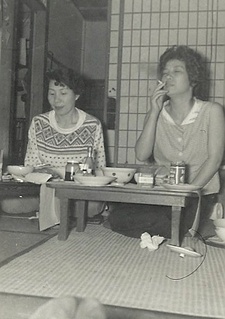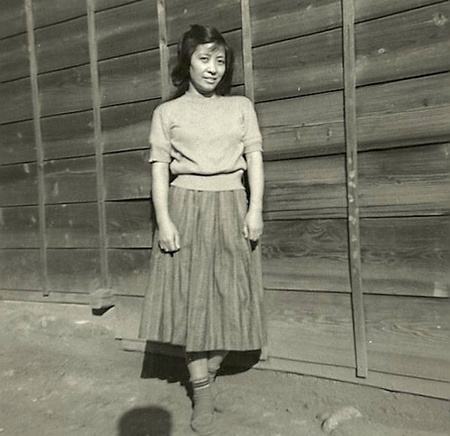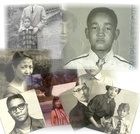Read “Part 3: Watermelon Seeds [2 of 2]” >>
Neighbors/Next door, Mama around 1940
となり、昭和15年ごろ
“These expressions are extremely crude and regional, and have a rustic air; middle-class Tokyo residents would laugh at their provincial quaintness.”
—Dorinne Kondo1
We were obviously not 江戸っ子 Edokko.2 People reminded us that we were foreign and special, even though we were Japanese.
Older sister spoke louder than other girls around and liked to be around the girls who were always in trouble at school and were poor and rough. I was too young to know one way or another, what I wanted, but I knew that we were wealthy. Okaasan (Mother) was always in the house. She and father wanted us to speak upper-class Japanese, not the benjo-guchi (toilet-mouth) Japanese that older sister spoke. But we spoke Osaka-ben (Osaka language) at home and I spoke the Edokko Tokyo language.
When Okaasan went out, she would put on a wig that looked like a maiko-san (apprentice geisha), and she’d put on a kimono. But she was always really noticeable because she was at least a head taller than all the other women almost anywhere. The maids would dress me. Our maids were Chinese and Korean women. In China, many of my neighbors had Japanese maids too. But that changed after awhile. I think because of the war. First the maids would sometimes bathe me in the mornings, then when they would dry me, I would stick my arms straight out from my body toward the sides and the maids would put on my clothes for the day. But Okaasan would dress herself and she would always be in a hurry.
She came to our house later, after our family had been in Japan for a long time. She came from China after we had gotten there some time earlier with Otō-san (Father) and Onē-san (Older sister). My younger half-sister was away in a village somewhere in the North. I hardly ever saw her. There was some kind of family problem and Father did not want Imōto (younger sister) to be here. So Onē-san took care of me when Okaasan would go shopping. She would go shopping with two men who usually came over. They were very nice, I remember.
Otōsan did not want us to associate too much with the neighbors. The neighbors were always talking about other people and passing leaflets around and would invite us to meetings. I hated those meetings. I didn’t understand what they were talking about. They would talk and argue and sometimes one of the neighbors would be taken away by the kempeitai (special military police). These police and a few of the neighbors made sure that everything was orderly in the town. Whenever something controversial happened, one of the neighbors would be there. If it weren’t for the neighbors, the kempeitai would never come, I think.
There were always four or five neighbors who were especially passionate in their jobs to enforce their opinion that we should all be unified and be “good Japanese” no matter if everyone thought differently about what that was. Besides, being Japanese was not our only way of seeing ourselves. It was more important to refer to clan, region, city, status, jobs rather than calling ourselves Nippon-jin. We had to support the army. Of course Teruo-niichan (older brother Teruo) was a high-ranked soldier so it was assumed we were in support. We were proud of him. We went to the train station and watched him go as the smoke, steam, and clanking of the trains took him away to war. Okaasan would always cry and be sad for hours afterward.
One day, a group of about ten to twelve neighbors, I think, came to our house. “Gomenkudasai!!” they shouted as they entered the house, which is the standard Japanese greeting when you enter a home, but their politeness was more like a command. Onē-san and Otōsan (Older sister and Father), went to answer. I was a child so I couldn’t understand everything. But they were asking about mother. Lots of questions. They wanted her to come out. Otō-san and Onē-san told them that she was unavailable and was not at home. I don’t remember well, but I used to ask why Okaasan was hiding all time. Why did she have to? What was happening? I, then, remember feeling that we couldn’t trust our neighbors for some reason, and that this was why Father told us not to associate too much with the neighbors or tell them about our family or what we did or where we were from. I was too young to understand what was happening.
I don’t quite remember but, I think it was about a month later or so…I think I heard sister screaming from the furo-ba (bathtub room). I ran to where I heard the scream but I don’t remember this part. I think O-tō-san was speaking with someone, then soon there were many people in the house and then I think I was taken to our sleeping quarters. Later that evening, Otōsan sat me and Onēsan down and told us that Okaasan was dead. That’s all I remember.
I guess from what I remember, she died from overheating in the ofuro. Actually, I don’t know, I don’t remember. I wonder why? I wonder if I was ever told? It happens a lot you know, people dying in the ofuro; because Japanese baths are so hot and people stay in too long. I remember I cried and cried and cried. Okaasan was gone to Ano-yo (the other-world).
Note to question “reality”
“Tonari gumi” 隣組 “neighborhood association” groups:
The neighbors, as well as Mama’s family themselves, in Mama’s story, were not just people, as naïve people will think. It was Japan in the 1930s and ‘40s. These Tonari gumi associations in those times, were first formed by the ruling government during the Edo/Tokugawa period as a form of civil participation in neighborhood and national unity and then turned more intense as security assistance by the Japanese governments in the Edo period and subsequent periods in various forms. They were essentially “mutual aid” oriented, although changing their roles at different times leading into the postwar period and into the 1980s and ‘90s.
On September 11, 1940, the Tonari gumi were re-formalized by the imperial government of Japan as neighborhood watches assisting in disaster relief, assisting the central government in assuring moral and ethical codes of the nation were followed in the neighborhoods, civil defense, and organizing and spreading propaganda along national lines. In addition, many of these groups also were ordered to perform “national spiritual unity” propaganda.
During the Second World War, which is the time and context in which my mother’s earlier life history is set, the neighborhood associations also assisted the special police (Tokkō Police—tokkō keisatsu) as informants, accusing people of being spies. During this period, the tonari-gumi groups, who were everyday neighbors, were always suspicious of Chinese, the Koreans, and all Westerners, and accused many of being spies and/or anti-Japanese. Since it was mandatory, the Kakinami family participated but due to the Kakinami clan’s status they were not bothered too much. Apparently, Grandfather often had to throw the more “nosy” and stubbornly nationalist ones out of the house.

Perhaps you can detect here a little, the touch of Mama's rough "rebel" personality in this photo as she smokes with her friend Keiko in 1957. I was about two years old at this time
All this talk about culture and race and political climate—where do these things begin and end? What things protect and also harm? What helps surveillance and who becomes the one that does the surveiling? What becomes, then, death and personality while memory is fractured and ambivalent? To a little girl, and most likely to the readers of this memory, the neighbors were nosy neighbors. Mama’s family was just Mama’s family in the ‘40s.
But now we realize a complex nexus of government-created squads combined with patriotic neighbors doing their duties, while others like my mother’s family, resisted to varying degrees. What differences are bound-up in creating and forming the contours of Mama’s memories (forgetting and remembering)? Yours and mine? Traumatic memory and suppression, yes. But what of other things not considered trauma but are?
Can we take care of our minds and assumptions differently?
Notes:
1. From “The Narrative Production of ‘Home,’ Community, and Political Identity in Asian American Theater” in Displacement, Diaspora, and Geographies of Identity. Edited by Smadar Lavie and Ted Swedenburg, Duke University Press, 1996.
2. Edokko 江戸っ子 is a term that is rarely used today. It has gradually become more of a pejorative word meaning country bumpkin, commoner, uneducated. This interpretation began during the Tokugawa period. Traditionally, Edokko referred to people whose family clan heritage were from Edo, the former name for Tokyo. It meant that Tokyo-ites were not traditional. They were more outspoken, cheerful, and would speak more directly as opposed to the traditional Japanese. Gradually as urbanization via the creation of a unified Japan became an everyday motif, and the word moved from a mere labeling of urban Tokyo residents and lineages with a distinct urban and more individualistic personality, it began to refer to commoners who weren’t modern enough.
This is an anthropology of memory, a journal and memoir, a work of creative non-fiction. It combines memories from recall, conversations with parents and other relations, friends, journal entries, dream journals and critical analysis.
To learn more about this memoir, read the series description.
© 2011 Fredrick Douglas Cloyd







